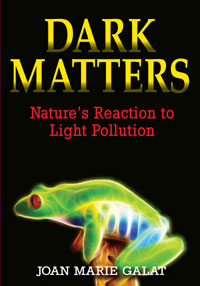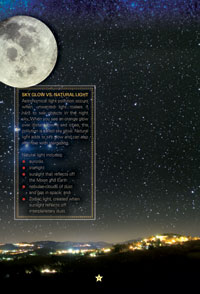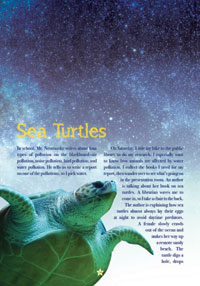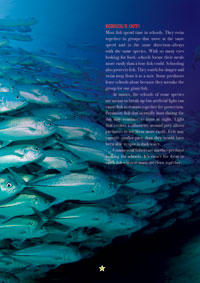| ________________
CM . . .
. Volume XXIV Number 23. . . .February 16, 2018

 |
Dark Matters: Natureís Reaction to Light Pollution.
Joan Marie Galat.
Markham, ON: Red Deer Press, 2017.
70 pp., hardcover, $19.95.
ISBN 978-0-88995-515-8.
Subject Heading:
Light pollution-Juvenile literature.
Grades 4-8 / Ages 9-13.
Review by Gillian Richardson.
***Ĺ /4
|
| |
|

excerpt:
Iím sure itís easier to be a human than to be an animal. At bedtime, I shut the blinds, close the curtains, and crawl into bed. Everyone knows itís easier to fall asleep in the dark. I once saw Aunt Florence sleep wearing an eye mask to keep the light out. It must have worked because she was snoring pretty loudly.
A lot of animals need dark to sleep, too. Sleep is necessary for survival. It keeps the mind and body working properly. Animals that donít get enough shut-eye become forgetful.
Nocturnal animal, like bats, are active at night and sleep during the day. Other species are diurnalóadapted to be active during the day and sleep at night. Some animals, like porcupines, are crepuscular. That means that they are most active during the dimly lit twilight hours around sunrise and sunset.
No matter what time they are most active, all animals need darkness. Nocturnal animals are adapted to capture food and avoid enemies in dark environments. Animals that are active at night face less competition for food, water, shelter, and space. Diurnal animals, like red squirrels, need darkness to hide from predators and feel safe enough to sleep. But squirrels canít close drapes or put on an eye mask like Aunt Flo.
Young readers know about different kinds of pollution that they see frequently: smog, oil spills, litter. Not normally being creatures of the night, though, they may not think as much about light pollution. Dark Matters addresses this concern by focusing on how animals and plants in every kind of ecosystem are affected in varying degrees by degradation of the dark. The author recalls her experiences as a young person in evening and nighttime activities, weaving the observations in an engaging storytelling style through factual text to show the effects of light pollution.
 The growth of human populations has created this problem in various forms: glare, light trespass, sky glow, over-illumination and clutter. The book deals at length with how reduced darkness interferes with the natural behaviors of birds, bugs, amphibians, nocturnal animals such as bats, as well as people and plants in both land and ocean habitats. Interspersed are definitions of terms, such as light, ecosystems, night vision, and fact boxes to explain such things as sky glow vs. natural light and FLAP (Fatal Light Awareness Program) that urges cities to turn off high-rise lights during migration season. A concluding page summarizes thoughts about the costs of overusing artificial light, notes that more study in Scotobiology (the biology of darkness) is required to fully understand those impacts, and suggests how the young reader can help by being more alert to the problem and enjoying ďthe darkness and all the night has to offerĒ. Search words are offered for further investigation on the Internet. The book has no index.
The growth of human populations has created this problem in various forms: glare, light trespass, sky glow, over-illumination and clutter. The book deals at length with how reduced darkness interferes with the natural behaviors of birds, bugs, amphibians, nocturnal animals such as bats, as well as people and plants in both land and ocean habitats. Interspersed are definitions of terms, such as light, ecosystems, night vision, and fact boxes to explain such things as sky glow vs. natural light and FLAP (Fatal Light Awareness Program) that urges cities to turn off high-rise lights during migration season. A concluding page summarizes thoughts about the costs of overusing artificial light, notes that more study in Scotobiology (the biology of darkness) is required to fully understand those impacts, and suggests how the young reader can help by being more alert to the problem and enjoying ďthe darkness and all the night has to offerĒ. Search words are offered for further investigation on the Internet. The book has no index.
 The light, amusing diary style of presentation is especially effective for the target audience. Itís easy to put yourself in the authorís shoes as she describes her first awareness of ubiquitous artificial light, adventures with stargazing, witnessing the proliferation of lighting in her neighborhood and town, seeing firsthand how migrating birds are disoriented by city lights, how behaviors of frogs and insects change, and discovering that even species living in deep underwater environments are now bothered by artificial light. She recounts how, growing up in the 1970s and 80s, her keen interest in natural history leads to a first volunteer job at a nature centre and later results in a career in the field of ecology. Through these stories of the evolution of light pollution and the rising concern of scientists for its negative impacts, readers are able to share the history of this serious problem and understand the need for mitigation, and perhaps be inspired to pursue science careers themselves. The light, amusing diary style of presentation is especially effective for the target audience. Itís easy to put yourself in the authorís shoes as she describes her first awareness of ubiquitous artificial light, adventures with stargazing, witnessing the proliferation of lighting in her neighborhood and town, seeing firsthand how migrating birds are disoriented by city lights, how behaviors of frogs and insects change, and discovering that even species living in deep underwater environments are now bothered by artificial light. She recounts how, growing up in the 1970s and 80s, her keen interest in natural history leads to a first volunteer job at a nature centre and later results in a career in the field of ecology. Through these stories of the evolution of light pollution and the rising concern of scientists for its negative impacts, readers are able to share the history of this serious problem and understand the need for mitigation, and perhaps be inspired to pursue science careers themselves.
A couple of the storytelling sections feel overly long. The effects of light on migrating birds, for instance, is introduced by a couple of pages of the authorís first experiences writing for a local newspaper. The story of how a bat accidentally gets into the house is prefaced by somewhat slow, unnecessary detail of how the teenage author was allowed to try driving her auntís car. The bat adventure, itself, is exciting, though, and leads nicely into well-researched facts about bat behavior.
 Photos chosen for the book are excellent. The starry night sky is used as the backdrop/theme for most pages Ė very effective to tie the book together, but it will be best to read it in good light as the blue/black star-dappled image often bleeds down to partly obscure the top lines of text.
Photos chosen for the book are excellent. The starry night sky is used as the backdrop/theme for most pages Ė very effective to tie the book together, but it will be best to read it in good light as the blue/black star-dappled image often bleeds down to partly obscure the top lines of text.
Dark Matters is an essential book for everyone to read. We may feel somewhat powerless about the scope of air and water pollution, but we can definitely act to reduce light pollution in our immediate surroundings. Share this book with young people to help them get the message.
Highly Recommended.
Gillian Richardson is a freelance writer living in BC.

© CM Association
CC BY-NC-ND
Hosted by:
University of Manitoba
ISSN 1201-9364
|
This Creative Commons license allows you to download the review and share it with others as long as you credit the CM Association. You cannot change the review in any way or use it commercially.
Commercial use is available through a contract with the CM Association. This Creative Commons license allows publishers whose works are being reviewed to download and share said CM reviews provided you credit the CM Association. |
Next Review | Table of Contents for This Issue - February 16, 2018.
CM Home | Back Issues | Search | CM Archive | Profiles Archive
|

 The growth of human populations has created this problem in various forms: glare, light trespass, sky glow, over-illumination and clutter. The book deals at length with how reduced darkness interferes with the natural behaviors of birds, bugs, amphibians, nocturnal animals such as bats, as well as people and plants in both land and ocean habitats. Interspersed are definitions of terms, such as light, ecosystems, night vision, and fact boxes to explain such things as sky glow vs. natural light and FLAP (Fatal Light Awareness Program) that urges cities to turn off high-rise lights during migration season. A concluding page summarizes thoughts about the costs of overusing artificial light, notes that more study in Scotobiology (the biology of darkness) is required to fully understand those impacts, and suggests how the young reader can help by being more alert to the problem and enjoying ďthe darkness and all the night has to offerĒ. Search words are offered for further investigation on the Internet. The book has no index.
The growth of human populations has created this problem in various forms: glare, light trespass, sky glow, over-illumination and clutter. The book deals at length with how reduced darkness interferes with the natural behaviors of birds, bugs, amphibians, nocturnal animals such as bats, as well as people and plants in both land and ocean habitats. Interspersed are definitions of terms, such as light, ecosystems, night vision, and fact boxes to explain such things as sky glow vs. natural light and FLAP (Fatal Light Awareness Program) that urges cities to turn off high-rise lights during migration season. A concluding page summarizes thoughts about the costs of overusing artificial light, notes that more study in Scotobiology (the biology of darkness) is required to fully understand those impacts, and suggests how the young reader can help by being more alert to the problem and enjoying ďthe darkness and all the night has to offerĒ. Search words are offered for further investigation on the Internet. The book has no index.
 The light, amusing diary style of presentation is especially effective for the target audience. Itís easy to put yourself in the authorís shoes as she describes her first awareness of ubiquitous artificial light, adventures with stargazing, witnessing the proliferation of lighting in her neighborhood and town, seeing firsthand how migrating birds are disoriented by city lights, how behaviors of frogs and insects change, and discovering that even species living in deep underwater environments are now bothered by artificial light. She recounts how, growing up in the 1970s and 80s, her keen interest in natural history leads to a first volunteer job at a nature centre and later results in a career in the field of ecology. Through these stories of the evolution of light pollution and the rising concern of scientists for its negative impacts, readers are able to share the history of this serious problem and understand the need for mitigation, and perhaps be inspired to pursue science careers themselves.
The light, amusing diary style of presentation is especially effective for the target audience. Itís easy to put yourself in the authorís shoes as she describes her first awareness of ubiquitous artificial light, adventures with stargazing, witnessing the proliferation of lighting in her neighborhood and town, seeing firsthand how migrating birds are disoriented by city lights, how behaviors of frogs and insects change, and discovering that even species living in deep underwater environments are now bothered by artificial light. She recounts how, growing up in the 1970s and 80s, her keen interest in natural history leads to a first volunteer job at a nature centre and later results in a career in the field of ecology. Through these stories of the evolution of light pollution and the rising concern of scientists for its negative impacts, readers are able to share the history of this serious problem and understand the need for mitigation, and perhaps be inspired to pursue science careers themselves.
 Photos chosen for the book are excellent. The starry night sky is used as the backdrop/theme for most pages Ė very effective to tie the book together, but it will be best to read it in good light as the blue/black star-dappled image often bleeds down to partly obscure the top lines of text.
Photos chosen for the book are excellent. The starry night sky is used as the backdrop/theme for most pages Ė very effective to tie the book together, but it will be best to read it in good light as the blue/black star-dappled image often bleeds down to partly obscure the top lines of text.